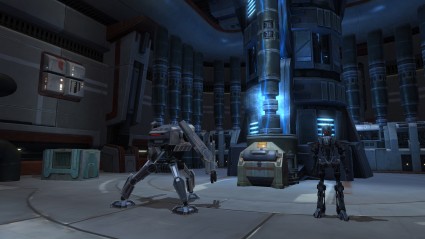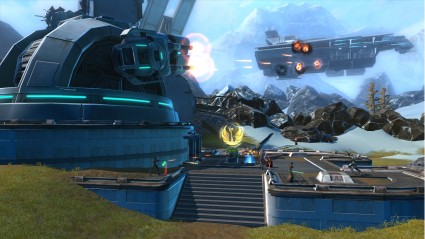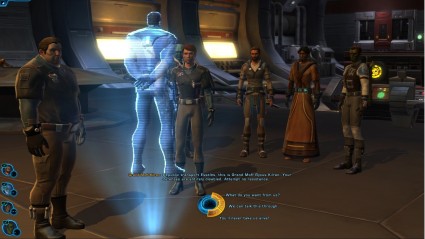Features & News
Hands On: Star Wars: The Old Republic
November 30, 2011, Author: Diogo Miguel
A long time ago in a galaxy far away, George Lucas came up with what turned out to be a very lucrative film franchise. Star Wars has gone on to become widely recognised all over the world. It didn’t stop at the films either; since Star Wars has dabbled in other media forms such as cartoons, comics and obviously video-games. There has been various Star Wars games and even a few with LEGO versions to boot, but it’s the PC games that fans love playing the most. The latest PC game in development is the MMO Star Wars: The Old Republic.
Star Wars: The Old Republic is very straightforward when it comes to the character classes. There’s eight of them split up between three groups consisting of Jedi, Bounty Hunter, and Troopers. These groups are then split into two factions. There’s certainly no lack of choice when it comes choosing a character and it’s even possible to personalise physical appearance. What is even better is that each class will have specific abilities. This makes it possible to pick a character that best suits the way that a player tends to play online games.
The character that I used the most throughout my time playing the game is a medic. It might seem dull to pick a medic. In theory a medic will only heal others but it’s actually the complete opposite. The mercenary healer that I played as can also use weapons and even has access to a powerful flying attack strike. Other characters have different attributes such as the Jedi classes which focus on close range attacks. The possibility to learn abilities is also a useful resource as it means characters can get access to abilities they wouldn’t get through natural progression.

These are probably the droids you're looking to kill.
It’s often the case that online PC games end up using so many keyboard/mouse buttons that it ends up scaring away beginners. That is not the case with this game as it relies on buttons found on the screen . Movement is restricted to a few selected keyboard keys and there is no need to move the camera around. This alone makes it easier to get used to when first starting out. Abilities are used by clicking on icons found at the bottom of the screen. It’s incredibly helpful that there is no limit to how many times abilities get used. Instead abilities will only take a certain amount of time before being usable again.
If using offensive abilities, then a target must first be selected. The same applies when using healing abilities. This process is made easier by using keyboard and mouse shortcuts to select targets. The fact that the game lets players pick a suitable control type from a range of options is also very helpful.
There’s a lot of dialogue in this game that is worth about sixty novels, which is impressive. It’s not a surprise considering the amount of characters that I came across while playing the game, though. In order to progress; it’s necessary to interact with certain characters that offer missions or flashpoints, as they are referred to in this game. When interacting with characters you have a range of choices in dialogue, typical of the work of Bioware.
There is a timer, however, which means a dialogue option gets picked if someone is taking too long. Each dialogue branch will result in a different outcome and have long-term effects on how other personalities perceive player characters. Some of the dialogue options are pretty funny and will make a few people laugh, but they also do a superb job of moving the story forward by letting players know what to do next.

Lots of different places to explore...
Once inside a flashpoint level, players will need to work together to clear each enemy-filled room. All the flashpoints that I’ve played, took place aboard spaceships but there’s hours of exploration ahead with ten planets to play through. Some of the enemies found included robots and other characters from the rival faction. Each requires a different approach, so it comes down to finding effective strategies when fighting them. It’s a good way of making sure that the game does not become repetitive.
Attempting to do flashpoints without companions is not a good idea. I attempted a few of them and didn’t get too far before being swiftly defeated. This makes sense since the game is supposed to be a multiplayer experience, but it’s still frustrating to think how difficult it might be with one player. It could, however, be the case that it will get easier with experience after playing through earlier flashpoint levels.

The dialogue tree might look familiar...
Star Wars: The Old Republic is an interesting proposition when comparing it to the various MMOs already out on PC. It has all the right elements that make up a game focused heavily on large multiplayer gaming sessions, and while the ideas behind dialogue system are not new, offer an interesting way to narrate a deep story in the vast Star Wars universe. This might just be the game that manages to get lots of gamers through the Christmas period this year. The force is certainly strong with Star Wars: The Old Republic if the rest of the game manages to live up to expectations.
Don’t forget to check out Ray’s Beta impressions, found here.
Feature Type: Hands On | Tagged Bioware, Boba Fett, Bounty Hunter, george lucas, Jabba the Hut, Jedi, Lightsaber, Princess Leia, Princess Leia bikini, Star Wars, Star Wars: The Old Republic


